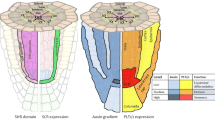Abstract
Root apical meristems (RAMs) in dicotyledonous plants have two organizational schemes; closed (with highly organized tiers) and open (tiers lacking or disorganized). These schemes are commonly believed to remain unchanged during the growth of the root axis. Individual roots are commonly thought to have indeterminate growth. We challenge these two generalizations through the study of five species with closed apical organization: Clarkia unguiculata L., Oxalis corniculata L., Dianthus caryophyllus L., Blumenbachia hieronymi Urb., and Salvia farinaceae Benth. cv. “Strata”. These roots have phased growth patterns where early growth is followed by deceleration, after which the initial cells stop dividing, elongation ceases, and the root reaches its determinate length. At or before reaching determinacy, the root apical meristem stops maintaining its closed organization and becomes less organized. These observations will be placed in context with observations from the literature to suggest two new generalizations, namely, that apical organization does change over the growth phases of roots, and that roots are determinate.



Similar content being viewed by others
References
JE Armstrong C Heimsch (1976) ArticleTitleOntogenetic reorganization of the root meristem in the Compositae. Am J Bot 63 212–219 Occurrence Handle10.2307/2441702
SF Baum JG Dubrovsky TL Rost (2002) ArticleTitleApical organization and maturation of the cortex and vascular cylinder in Arabidopsis thaliana (Brassicaceae) roots. Am J Bot 89 908–920 Occurrence Handle10.3732/ajb.89.6.908
J Cheng KA Seeley ZE Sung (1995) ArticleTitleRML1 and RML2, Arabidopsis genes required for cell proliferation at the root tip. Plant Physiol 107 365–376 Occurrence Handle1:CAS:528:DyaK2MXjvVGhu7c%3D Occurrence Handle10.1104/pp.107.2.365 Occurrence Handle7724670
B Denkelaker C Hengeler H Marschner (1995) ArticleTitleDistribution and function of proteoid roots and other root clusters. Bot Acta 108 183–200
JG Dubrovsky (1997) ArticleTitleDeterminate primary-root growth in seedlings of Sonoran desert Cactaceae; its organization, cellular basis, and ecological significance. Planta 203 85–92 Occurrence Handle1:CAS:528:DyaK2sXlvVChurg%3D
DK Gladish TL Rost (1993) ArticleTitleThe effects of temperature on primary root growth dynamics and lateral root distribution in garden pea (Pisum sativum L., cv. “Alaska”). Env Exp Bot 33 243–258 Occurrence Handle10.1016/0098-8472(93)90070-V
Groot EP, Chapman K, Rost TL. 2001a Root apical meristem organization is a dynamic character in dicot roots (Abstracts). Annual meeting of the Botanical Society of America, Albuquerque, NM. p 21.
Groot EP, Nichol SA, Doyle JA, Rost TL. 2001b. Phylogenetic relationships and root apical meristem organization in the dicots (Abstracts). Annual meeting of the Botanical Society of America, Albuquerque, NM p 21.
EP Groot EJ Sweeney TL Rost (2003) ArticleTitleDevelopment of the adhesive pad on climbing fig (Ficus pumila) stems from clusters of adventitious roots. Plant and Soil. 248 85–96 Occurrence Handle1:CAS:528:DC%2BD3sXhtFCru70%3D Occurrence Handle10.1023/A:1022342025447
H von Guttenberg (1968) Der primäre Bau der Angiospermenwurzel. Handbuch der Pflanzenanatomie. Band VIII, Teil 5. Gebruder Borntrager Berlin
BES Gunning (1978) ArticleTitleAge-related and origin-related control of the numbers of plasmodesmata in cell walls of developing Azolla roots. Planta 143 181–190 Occurrence Handle10.1007/BF00387786
MAW Hinchee TL Rost (1992) ArticleTitleThe control of lateral root development in cultured pea seedlings. II. Root fasciation induced by auxin inhibitors. Botanica Acta 105 121–126 Occurrence Handle1:CAS:528:DyaK3sXhvFemug%3D%3D
H Kaya K Shibahara K Taoka M Iwabucchi B Stillman T Araki (2001) ArticleTitleFASCIATA genes for chromatin assembly factor-1 in Arabidopsis maintain the cellular organization of apical meristems. Cell 104 131–142 Occurrence Handle1:CAS:528:DC%2BD3MXis1Oqs7o%3D Occurrence Handle10.1016/S0092-8674(01)00197-0 Occurrence Handle11163246
B Lamont (1972a) ArticleTitleThe morphology and anatomy of proteoid roots in the genus Hakea. Aust J Bot 20 155–172 Occurrence Handle10.1071/BT9720155
B Lamont (1972b) ArticleTitle‘Proteoid’ roots in the legume Viminaria juncea. Search 3 90–91
MVS Raju TA Steves RT Coupland (1963) ArticleTitleDevelopmental studies on Euphorbia esula L. morphology of the root system. Can J Bot 41 579–589 Occurrence Handle10.1139/b63-049
DH Reinhardt TL Rost (1995) ArticleTitleOn the correlation of primary root growth and tracheary element size and distance from the tip in cotton seedlings grown under salinity. Env Exp Bot 35 575–588 Occurrence Handle10.1016/0098-8472(95)00018-6
TL Rost (1994) Root tip organization and the spatial relationships of differentiation events. M Iqbal (Eds) Growth Patterns in Vascular Plants 1994. Dioscorides Press Portland, Oregon 59–76
TL Rost S Baum (1988) ArticleTitleOn the correlation of primary root length, meristem size and protoxylem tracheary element position in pea seedlings. Am J Bot 75 414–424 Occurrence Handle10.2307/2443988
JL Seago C Heimsch (1969) ArticleTitleApical organization in roots of the Convolvulaceae. Am J Bot 56 131–138 Occurrence Handle10.2307/2440698
EW Sinnott (1935) Botany Principles and Problems. McGraw-Hill Book Company, Inc. New York 525
KR Skene (1998) ArticleTitleCluster roots: some ecological considerations. J Ecol 86 1060–1064 Occurrence Handle10.1046/j.1365-2745.1998.00326.x
GT Varney ME McCully (1991) ArticleTitleThe branch roots of Zea. II. Developmental loss of the apical meristem in field-grown roots. New Phytol 118 535–546 Occurrence Handle10.1111/j.1469-8137.1991.tb00993.x
XL Wang ME McCully MJ Canny (1994) ArticleTitleThe branch roots of Zea. IV. The maturation and openness of xylem conduits in first-order branches of soil-grown roots. New Phytol 126 21–29 Occurrence Handle10.1111/j.1469-8137.1994.tb07525.x
T Zhu RL O'Quinn WJ Lucas TL Rost (1998) ArticleTitleDirectional cell-to-cell communication in the Arabidopsis root apical meristem. II. Dynamics of plasmodesmatal formation. Protoplasma 204 84–93 Occurrence Handle10.1007/BF01282296
Acknowledgements
Shelly Duplessis, Lesley Hamamoto and Eileen Sweeney are acknowledged for their assistance in this study. Dr. Wendy Silk is also acknowledged for the loan of her rhizotron.
Author information
Authors and Affiliations
Corresponding author
Rights and permissions
About this article
Cite this article
Chapman, K., Groot, E., Nichol, S. et al. Primary Root Growth and the Pattern of Root Apical Meristem Organization are Coupled . J Plant Growth Regul 21, 287–295 (2002). https://doi.org/10.1007/s00344-002-0036-x
Received:
Accepted:
Published:
Issue Date:
DOI: https://doi.org/10.1007/s00344-002-0036-x




